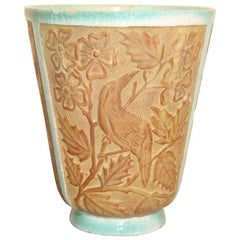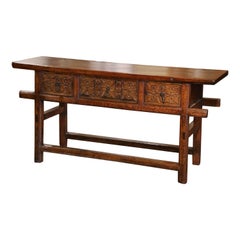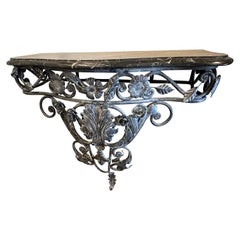Saca On Sale
Elegant Mid-Century Italian Vase Saca, 1940s
By Saca
Located in Palermo, Sicily
Mid-century Italian vase Saca, 1940s.
Category
Vintage 1940s Italian Mid-Century Modern Vases
Materials
Ceramic
People Also Browsed
Early 20th Century Spanish Baroque Carved Pine & Oak Three-Drawer Console Table
Located in Dallas, TX
Place this elegant antique console table behind a sofa or against a wall. Crafted in Spain circa 1920 and built of oak and pine, the Baroque sofa table sits on square legs connected ...
Category
Early 20th Century Spanish Baroque Console Tables
Materials
Oak, Pine
H 32 in W 66 in D 19 in
Antique French Marble Top Iron Demilune Wall Console Table
Located in Summerland, CA
Bow front, Wall console table in floral wrought iron base. Top is black and white Italian marble with bevel edge.
Category
Vintage 1920s French Console Tables
Materials
Marble, Iron
Early 20th Century Spanish Carved Console Table with Two drawers
Located in Miami, FL
Early 20th Century Spanish Colonial Walnut Console ~ Sofa Table is a splendid reminder of a bygone era! Hand-crafted from old growth walnut, it features a single thick plank of solid...
Category
Early 20th Century Spanish Baroque Console Tables
Materials
Walnut
Old Wrought Iron French Marble Console or Hall Table
Located in Chillerton, Isle of Wight
Old Wrought Iron French Marble Console or Hall Table
This is a very attractive piece, the table has decorative scroll and shell decoration to the iron leg which is in a shabby moss ...
Category
Antique 1890s French Provincial Console Tables
Materials
Marble
Victorian Wrought Iron Side Gate with Scrolling Brackets
Located in Wormelow, Herefordshire
An ornately detailed Victorian wrought iron side gate dating from the 1880s. With its repeated scrolling pattern, this beautiful reclaimed wrought iron gate is a stunning addition to...
Category
Antique Late 19th Century English Victorian Doors and Gates
Materials
Metal, Iron, Wrought Iron
Two Antique Marble Top Console Tables
Located in Wormelow, Herefordshire
A highly decorative pair of antique console tables. Ornately decorated with stylised dragons, crowns, foliage and swags, these tables blend modern components with classical styling, ...
Category
Antique Late 19th Century English Victorian Console Tables
Materials
Carrara Marble, Marble, Metal, Iron
17th Century Spanish Carved Walnut Five-Leg Single Plank Top Console Table
Located in Dallas, TX
This elegant antique fruitwood console was crafted in Spain, circa 1680. Hand carved on all four sides, the long sofa table stands on five thick turned legs ending with bun feet over...
Category
Antique Late 17th Century Spanish Louis XIII Console Tables
Materials
Walnut
H 31.5 in W 76 in D 25.5 in
Arnaldo Miniati Pair of Ceramic and Iron Demi-Lune Wall Consoles, Italy, 1959
By Arnaldo Miniati
Located in New York, NY
A pair of painted ceramic demi-lune wall consoles, by ceramist and artist Arnaldo Miniati, signed and dated 1959.
Size: 37 1/4" high x 23" wide x 11 1/4" deep
The demi-lune table...
Category
Vintage 1950s Italian Mid-Century Modern Console Tables
Materials
Wrought Iron
H 37.25 in W 23 in D 11.25 in
Wrought Iron Specimen Marble Topped Console Table
Located in Hudson, NY
This fine wrought iron wall mounted console table is made up from 18th century parts with early 20th century additions. The 18th-century middle section (see image 6) was probably par...
Category
Early 20th Century Console Tables
Materials
Marble, Iron
Antique Carrara Marble Wall Mounted Console Table
Located in Wormelow, Herefordshire
Though this antique Carrara marble wall mounted console table dates from the mid 19th century, it is a timeless furniture piece for homes old and new. The marble surface displays bea...
Category
Antique Mid-19th Century English Victorian Console Tables
Materials
Carrara Marble, Marble, Metal, Wrought Iron, Iron
Wrought Iron and Marble Console, France, 19th Century
Located in Isle Sur La Sorgue, Vaucluse
Rare, lovely quality, heavy wrought iron console table with original marble top. The base features large cabriole legs adorned with curlicue details, and ending in elegant scrolled f...
Category
Antique Late 19th Century French Console Tables
Materials
Marble, Wrought Iron
Pair of Artistic Iron and Ceramic Tile Consol
By Joseph Malekan
Located in Delray Beach, FL
Exceptional pair of console made of antique hand-wrought iron base ,originally
From India ,put together and then add the top by the artist , the top is made with one old flat Persia...
Category
20th Century Console Tables
Materials
Wrought Iron
Italian Mid-Century Modern Neoclassical Iron Console /Sofa Table, Giovanni Banci
By Giovanni and Alessandro Banci
Located in New York, NY
A deeply and sharply hand-hammered console in the style of Giovanni Banci in the modern neoclassical spirit. This Mid-Century piece features a dramatic hand-wrought ancient Celtic sy...
Category
Mid-20th Century Italian Mid-Century Modern Console Tables
Materials
Stone, Wrought Iron
H 34 in W 51.25 in D 15.75 in
Get Updated with New Arrivals
Save "Saca On Sale", and we’ll notify you when there are new listings in this category.
Questions About Saca On Sale
- Does Fendi have sales?1 Answer1stDibs ExpertApril 5, 2022Yes, Fendi is known to hold sales on different items. Sales vary from location to location. For more information, contact your local authorized Fendi retailer. On 1stDibs, you’ll find a collection of vintage and contemporary Fendi apparel and accessories from some of the world’s top boutiques.
- Does Mikimoto have sales?1 Answer1stDibs ExpertMarch 22, 2022Yes, the Mikimoto online store sometimes runs sales, especially around Valentine's Day and at the start of the holiday season. Third-party retailers may also discount prices on Mikimoto pieces, and you may find deals on their jewelry year-round on various online platforms. Shop a variety of expertly vetted Mikimoto jewelry on 1stDibs.
- Does dior go on sale?1 Answer1stDibs ExpertApril 5, 2022Dior boutiques often have sales at the end of the season on select items. The best way to find out is to ask your nearest location or keep an eye on the inventory. For physical store locations, consult the brand’s website. Shop iconic vintage and contemporary Dior clothing and accessories on 1stDibs.
- Does Louis Vuitton have sales?1 Answer1stDibs ExpertMarch 7, 2024No, Louis Vuitton products are never marked down — and unless they are secondhand, any discounted Louis Vuitton items are likely to be counterfeit. To ensure you purchase authentic, high quality Louis Vuitton products, look for a reputable seller. Shop authentic Louis Vuitton handbags and purses, clothing and accessories from top sellers around the world on 1stDibs.
- Does Stuart Weitzman have sales?1 Answer1stDibs ExpertApril 16, 2024Yes, Stuart Weitzman does have sales. The luxury brand runs promotional sales on its official website and brick-and-mortar stores. Often, these sales occur at the end of seasons and at certain times of the year, such as Black Friday. Explore a collection of Stuart Weitzman shoes from some of the world's top sellers on 1stDibs.
- Does Versace go on sale?1 Answer1stDibs ExpertApril 5, 2022You can find great sales on Versace's ready-to-wear items, bags, accessories and even home decor on the brand’s website, its brick-and-mortar boutiques, or through various online and in-store retailers. On 1stDibs, find Versace clothes, accessories and home decor from top sellers around the world.
- When does Fendi go on sale?1 Answer1stDibs ExpertMarch 22, 2022Fendi tends to go on sale at the end of the spring/summer and fall/winter seasons to make room for new inventory. At other times of the year, authorized brick-and-mortar retailers and online platforms may offer sale prices on the brand's apparel and accessories. On 1stDibs, shop a selection of Fendi.
- When is Gucci’s private sale?1 Answer1stDibs ExpertApril 5, 2022Gucci was known to have a private sale twice a year; however, the last known sale happened in 2016. But don’t fret, you can find vintage and contemporary Gucci looks from top sellers around the world on 1stDibs.
- Does Balenciaga goes on sale?1 Answer1stDibs ExpertApril 5, 2022Yes, Balenciaga boutiques have a couple of sales a year, but that depends on the store and the country in which it’s located. Additionally, Balenciaga’s retail partners often have sales and those sales may or may not include items by the brand. On 1stDibs, find vintage and contemporary Balenciaga haute couture from top sellers around the world.
- 1stDibs ExpertMarch 22, 2022Normally, Herman Miller has two sales each year. The first takes place in the spring, and the second is usually in the fall around the start of shopping for the holiday season. Year-round, other online platforms may offer discounts on Herman Miller. On 1stDibs, shop a collection of Herman Miller furniture.
- Does Hermes ever go on sale?1 Answer
 ChicjoySeptember 24, 2020
ChicjoySeptember 24, 2020Select Hermes goods go on sale twice a year in Paris, but Birkins – being highly coveted–are not known to be found at the sale.
- 1stDibs ExpertMarch 22, 2022Yes, Dior runs sales for Black Friday and other occasions throughout the year. Promotions vary and usually do not include all the items in the online store's inventory. You also may find Dior apparel, jewelry and accessories available at discounted prices year-round on online platforms. Shop a large selection of Dior on 1stDibs.
- 1stDibs ExpertFebruary 22, 2021No Louis Vuitton never has sales. On 1stDibs, however, you can find Louis Vuitton bags in a variety of styles and colors at a range of prices.
- 1stDibs ExpertMarch 22, 2022Yes, Roche Bobois does have sales. Specifically, the luxury furniture manufacturer usually discounts items twice per year in the winter and spring. Throughout the year, you may find their pieces available for reduced prices on some reputable online platforms, as well. On 1stDibs, shop a selection of Roche Bobois.
- Do Loewe bags go on sale?1 Answer1stDibs ExpertMarch 22, 2022No, Loewe bags typically do not go on sale on the brand's official online store or at their brick-and-mortar locations. Authorized third-party retailers do sometimes discount bags, and you may find them at reduced prices on reputable online platforms. Shop a variety of Loewe bags on 1stDibs.
- 1stDibs ExpertMarch 22, 2022Herman Miller actually has two sales each year rather than one annual sale. The specific dates of the sales vary. However, most years, the sales take place once in the spring and once in the fall. You may find Herman Miller available for discounted prices on other online platforms year-round. Find a collection of Herman Miller furniture on 1stDibs.
- 1stDibs ExpertApril 16, 2024No, Tiffany & Co. generally does not ever have a sale. During its more than 100-year history, the American luxury jewelry maker has reportedly never run a sale. However, Tiffany & Co. does offer jewelry at a wide range of prices to suit a variety of budgets. Shop a diverse assortment of Tiffany & Co. jewelry on 1stDibs.
- 1stDibs ExpertApril 5, 2022Bottega Veneta items will sometimes go on sale from different retailers, though this varies depending on location. Contact specific authorized retailers near you for more information. On 1stDibs, you’ll find a large collection of vintage and contemporary Bottega Veneta fashion and accessories from some of the world’s top boutiques.
- Does Bottega Veneta go on sale?1 Answer1stDibs ExpertApril 5, 2022Yes, you can find Bottega Veneta on sale at various high-end retailers and department stores throughout the year. You may also find vintage Bottega Veneta items on sale through a variety of online third-party sellers. On 1stDibs, you'll find a collection of authentic Bottega Veneta pieces.
- Does Dolce & Gabbana go on sale?2 Answers1stDibs ExpertMarch 22, 2022No, Dolce and Gabbana does not usually go on sale. The brand's official online store and brick-and-mortar boutiques typically do not discount apparel and accessories. However, some authorized retailers and various online platforms may mark down Dolce and Gabbana or offer sales. You'll find a selection of Dolce and Gabbana on 1stDibs.1stDibs ExpertApril 5, 2022Yes, Dolce & Gabbana items are occasionally marked down, usually at the end of the season. Look for reputable sellers to ensure you purchase authentic, high-quality Dolce & Gabbana products. Find a range of genuine Dolce & Gabbana garments from some of the world’s top sellers on 1stDibs.
More Ways To Browse
Saca Italy
Saca Ceramic
Louis Philippe Antique Wardrobe
Vesta Case English
Velvet Covered Chaise Longues
Sterling Hepplewhite
Tiered Water Fountain
Teak Tall Boy
Used Turntable Record Player
Used Hobie
V Kagan
Paloma Sofa
Russian Hand Painted Lacquer Box
Saffo Lamp
Vintage Bedside Clocks
Arflex Elettra
Armband Vintage
Vintage Log Basket


